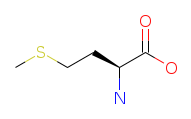Methionine
J. H. Muller, a researcher at Columbia University in New York, discovered a new amino acid Methionine back in 1922. He isolated it, but submitted an incorrect summation formula, which was corrected only 3 years later by his fellow researcher Odake from Japan. Odake was the one who gave a name to the amino acid - 'Methionine'. Finally, in another three years, Barger and Coyne identified the structure of Methionine.
Chemical Structure of L-Methionine
Chemical Structure
Identifiers and properties of Methionine
IUPAC Name: (2S)-2-Amino-4-methylsulfanylbutanoic acid
Symbol: Three-letter code - Met. One-letter code - M
Molecular Weight (Molar Mass): 149.21134 g/mol
Molecular Formula (Structural Formula): C5H11NO2S
Canonical SMILES: CSCCC(C(=O)O)N
Isomeric SMILES: CSCC[C@@H](C(=O)O)N
InChIKey Identifier: FFEARJCKVFRZRR-XWEZEGGSDQ
CAS Number: 63-68-3
MDL Number: MFCD00063097
Melting point: 284 °C
RNA codons: ATG
Solubility in water: 53.7 g/1 L (20 °C); pKa - 2,28; pKb - 9,21
Rf value in n-butanol/acetic acid/water = 12:3:5 - 0.55
IR and H1 NMR spectrum: n/a
MSDS (Material Safety Data Sheet): n/a
2D Molfile: Get the molfile
3D PDB file: Get the PDB file
Other names: L-2-Amino-4-(methylthio)butyric acid; S-Methionine; L-alpha-Amino-gamma-methylmercaptobutyric acid; (S)-2-Amino-4-(methylthio)butanoic acid; L-alpha-Amino-gamma-methylthiobutyric acid; L-gamma-Methylthio-alpha-aminobutyric acid; L-2-Amino-4-methylthiobutanoic acid
What is the role of Methionine?
Methionine is an essential amino acid which contains sulphur and which has the ability to 'donate' part of its structure to other molecules, thus altering them. It is therefore called a 'methyl donor'. The methyl molecule (a carbon-hydrogen combination designated CH₂) which is 'donated' is essential for formation of nucleic acid (RNA/DNA) the genetic material of every cell of the body which determines the formation of all the different proteins which make up our body.
Methionine gives rise to the amino acids cysteine and cysteine. Methionine, as well as cysteine and cystine can act as a powerful detoxification agent, being capable of the removal from the body of toxic levels of heavy metals such as lead.
Methionine is an antioxidant, and as such is a good free radical scavenger. Because it has a methyl group to offer it can combine with active free radicals which are harmful to the system. Studies show that alcohol is one oxidant which can stimulate the release of dangerous superoxide radicals. Methionine has shown protective effects against alcohol in this regard and in general. Methionine also aids in the maintenance of the pool of glutathione peroxidase, the powerful enzyme antioxidant.
Benefits of Methionine
Methionine is actually a supplier of sulfur and a few other compounds that our body needs for normal metabolism and growth. As you know, sulfur is a key element and very important to our life. If you lack an adequate intake of sulfur, your body will be unable to produce and to utilize some antioxidant nutrients. Therefore, Methionine is a very valuable nutritional compound providing numerous benefits for your body. For example, European doctors are using it to treat such conditions as depression, inflammation, liver diseases, and some muscle pains. This amino acid is particularly beneficial for people suffering from estrogen dominance, i.e. the amount of estrogen in the body is too high compared to that of progesterone. Besides, women taking oral contraceptives can also find Methionine very helpful - considering that estrogen is cleared through the liver, it is better to enhance the liver function to reduce the body's estrogen load.
Food sources of Methionine
Normally, most people do not need to take the Methionine supplementation when in good health. Naturally, you can get some of this amino acid from food like meat, fish, and dairy products. Here is a list of foods that are good sources of Methionine.
Meat and Poultry. Chicken breast: Approximately 0.92 grams per 100 grams. Turkey: About 0.84 grams per 100 grams. Beef: Contains around 0.61 grams per 100 grams.
Fish. Tuna: About 1.1 grams per 100 grams. Salmon: Contains around 0.9 grams per 100 grams.
Dairy Products. Eggs: One large egg contains about 0.65 grams of methionine. Milk: Approximately 0.04 grams per ounce.
Cheese. Parmesan cheese: About 1.33 grams per ounce. Cheddar cheese: Contains around 0.73 grams per ounce.
Nuts and Seeds. Sunflower seeds: Approximately 0.92 grams per ounce. Brazil nuts: About 0.74 grams per ounce. Peanuts: Contains around 0.22 grams per ounce.
Legumes. Lentils: Approximately 0.21 grams per 100 grams. Chickpeas: About 0.13 grams per 100 grams. Black beans: Contains around 0.15 grams per 100 grams.
Grains. Quinoa: About 0.28 grams per 100 grams. Oats: Contains around 0.32 grams per 100 grams.
Soy Products. Tofu: Approximately 0.48 grams per 100 grams. Tempeh: Contains around 0.73 grams per 100 grams. Soybeans: About 0.75 grams per 100 grams.
As with any nutrient, the actual methionine content can vary depending on factors such as the specific type or cut of the food and cooking methods. If you have specific dietary needs or restrictions, it's advisable to consult with a healthcare professional or a registered dietitian to ensure you are meeting your nutritional requirements. Balancing the intake of essential amino acids like lysine and methionine is important for overall health and well-being.